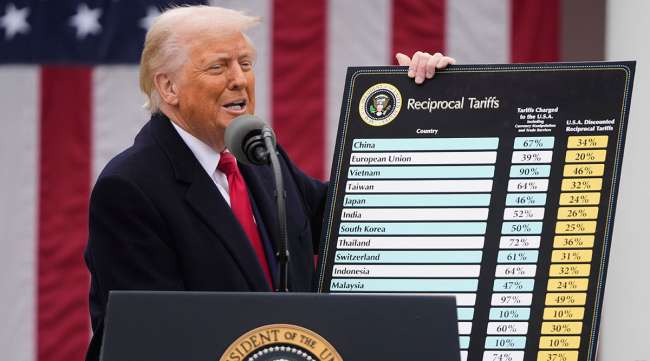President Donald Trump speaks during an event to announce new tariffs in the Rose Garden at the White House on April 2. (Mark Schiefelbein/Associated Press)
President Donald Trump rolled out a whole new set of tariffs in a move to promote U.S. manufacturing — but one that experts warn also could disrupt transportation and the supply chain.
The plan primarily centers on reciprocal tariffs, with 10% acting as a baseline for all imports. But in addition to that, numerous countries face additional tariffs for what the president views as unfair trade practices. This is part of an ongoing trade war the president has been waging, with much of the focus earlier centering on allies Canada and Mexico.
“With today’s action, we’re finally going to be able to make America great again, greater than it has ever been before,” Trump said right before revealing the details of his plan. “We will supercharge our domestic industrial base. We will pry open foreign markets and break down foreign trade barriers, and ultimately more production at home will mean stronger competition and lower prices for consumers. This will be indeed the golden age of America.”
Trump has leaned heavily on tariffs since starting his second term, including 25% levies on imported steel and aluminum, as well as goods from Mexico and Canada. China, hit with a 34% tariff, has been a big early target in the trade war too. The president also recently slapped a 25% tariff on all imported automobiles and automobile parts. The new tariffs were in addition to those in place and accounted for retaliatory tariffs as well.

Spear
In an April 2 message sent to members, American Trucking Associations President Chris Spear stressed that while this latest White House action could have been worse for trucking, it still creates challenges for the industry.
“Today’s announcement excluded additional tariffs on Canada and Mexico, a welcome reprieve as it relates to cross-border freight,” Spear said, but noted that goods from Canada and Mexico that are not USMCA-compliant already are subject to a 25% tariff. “USMCA-compliant goods will continue to see a 0% tariff, non-USMCA compliant goods will continue to see a 25% tariff, and non-USMCA compliant energy and potash will see a 10% tariff,” he said.
Spear noted that while Trump’s recent announcement of 25% tariffs on automobile imports excluded heavy-duty trucks, this latest action brings a new threat to the trucking industry.
“The tariffs announced today have potential to depress freight volumes and increase equipment costs for our industry,” he said. “We continue to express these concerns directly to administration officials. Our team is currently poring over the details of today’s announcement, and we’ll be assessing its impact on motor carriers and our supplier partners.”
LIBERATION DAY RECIPROCAL TARIFFS 🇺🇸 pic.twitter.com/ODckbUWKvO
— The White House (@WhiteHouse) April 2, 2025
“Over the weekend and leading up to the tariff announcement, we saw an extraordinary volume of trucks moving northbound from Mexico into the U.S., particularly along the I-35 corridor,” said Jose Guerrero, director of U.S. customs operations at Uber Freight. “Some importers held back shipments until the news was confirmed, while others rushed to move goods ahead of potential disruptions.

Guerrero
“This pattern suggests shippers are closely monitoring trade policy and adjusting their strategies in real time. We will continue tracking freight flows and shipper behavior in the coming days to understand the full impact on cross-border supply chains.”
Canada and Mexico still are subject to the 25% rate with the exception of goods covered under the United States-Mexico-Canada Agreement. Cambodia was hit with the highest rate at 49%. The other countries include Switzerland (31%), India (26%), Japan (24%) and the European Union (20%).
“Rising tariff threats have prompted businesses to pull forward inventory purchases, creating a challenging financial environment where companies must balance increased carrying costs against supply chain disruption risks,” said Sree Mangalampalli, vice president of digital transformation solutions at FourKites. “With interest rates already elevated, this inventory buildup places significant pressure on cash flow at a time when CFOs would typically be tightly managing inventory levels to improve their financial position.”

From left: Vice President J.D. Vance, Secretary of State Marco Rubio, Defense Secretary Pete Hegseth, Secretary of Agriculture Brooke Rollins and Secretary of Labor Lori Chavez-DeRemer listen to Trump from the front row. (Evan Vucci/Associated Press)
Mangalampalli added that the challenge is exacerbated since so few companies have real-time insights across their supply chains. This can make planning orders and inventories more difficult. He also stressed that organizations should optimize their warehouse and yard operations to efficiently manage increased inventory volume. He also warned that mismanaging this strategy, or just failing to adapt, could lead to economic consequences.
“Trump’s April 2 tariffs, intended to increase duties on various imported goods, may well create significant disruptions for U.S. supply chain and logistics operations,” said James Bryant, chief operating officer at RK Logistics Group. “Any business that relies on imported materials and components will see increased costs and potentially parts shortages, resulting in production delays and ultimately higher costs for consumers.”
More on Tariffs and the Economy
Bryant added that companies also may face higher costs from transportation and customs clearance fees as well as additional delays as manufacturers shift their sourcing strategies. He ultimately expects greater complexity in terms of managing supply chains since new relationships will need to be established and vetted.
“Such sourcing shifts, however, are major, complex changes for an enterprise,” Bryant said. “For logistics providers, demands could surface quickly to address needs for new or relocated warehousing resources in different geographies, capacity constraints, different cycle times and the agility to respond to unsettled and shifting supply chain flows.”

Bryant
Bryant concluded that overall, this round of tariffs could create a ripple effect that forces companies to reset their supply chain strategies and logistics operations in the face of rising costs and changing trade dynamics.
“The announced measures will be a significant milestone in the Trump administration journey to redefine global trade,” said Ram Ben Tzion, co-founder of the global trade vetting platform Publican. “Magnitude and extent indicate how serious the administration is about new tariffs.”
Tzion highlighted several immediate concerns businesses should be considering, such as delays and disruption being a possibility as logistics operators increase customs processing and clearance capacity to handle all the new regulations and tariff requirements. He also anticipates other countries possibly retaliating with tariffs and trade restrictions.
Want more news? Listen to today’s daily briefing below or go here for more info:






